Birds come in all shapes and sizes – out of over 440 species in Minnesota, there are plenty of those that are extremely small!
Birds evolved from a group of meat-eating dinosaurs called theropods. Bird ancestors realized that shrinking was the way to go forward in order to survive – this “miniaturization process” started some 200 million years ago.
Birds’ diminutive size proved to be useful for hiding and finding food in trees, crossing greater distances, and reaching new habitats.
Table of Contents
17 Small Birds In Minnesota
Examples of small birds in Minnesota include downy woodpeckers, common yellowthroats, brown creepers, house wrens, boreal chickadees, and many others.
The smallest bird in Minnesota is the ruby-throated hummingbird with a length of 2.8-3.6 inches, a wingspan of 3.1-4.3 inches, and a weight of just 0.07-0.2 ounces.
1. Downy Woodpecker
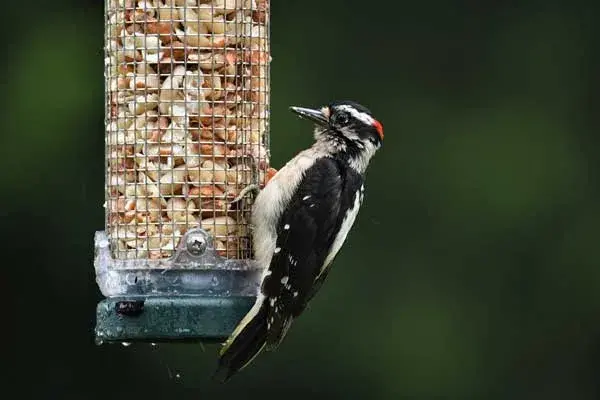
- Scientific Name: Picoides pubescens
- Length: 5.5-7.1 in
- Wingspan: 9.8-12.2 in
- Weight: 0.7-1.16 oz
Downy woodpeckers are the smallest woodpecker species in Minnesota and the entire North America. They measure as little as 5.5 inches in length and weigh as little as 0.7 oz.
Identify downy woodpeckers by their black upperparts and wings, white backs, throats, bellies, and white spottings on the wings. They also have one white bar above and below the eyes; adult males have red patches on the back of their heads.
Downy woodpeckers are permanent residents of Minnesota and can be seen in forests, parks, and gardens throughout the year. Their most common call is a short “pik” and they also make rattle-calls.
Downy Woodpecker Call | Source: G. McGrane, Public domain, via Wikimedia Commons
They have special feathers around their nostrils to save them from breathing in wood chips. Downy woodpeckers are omnivores that primarily feed on insects, beetle larvae, ants, caterpillars, berries, acorns, and grains.
Attract these tiny woodpeckers to your backyard by adding suet and black oil sunflower seeds to your feeder. Downy woodpeckers are monogamous and the pair will together prepare a nest in the tree. The female will then lay 3-8 eggs there.
2. Chimney Swift

- Scientific Name: Chaetura pelagica
- Length: 4.7-5.9 in
- Wingspan: 11-12 in
- Weight: 0.6-1.06 oz
Chimney swifts are the smallest swift species in Minnesota.
These gray birds with short squared tails, long wings, and tiny legs are summer residents of the state. Chimney swifts are fast, slender, and acrobatic birds that spent most of their time flying and hunting insects.
Unless you can’t spot chimney swifts gliding both in the city and in the country, listen for their twittering calls made of a rapid series of hard, high-pitched chirps.
Chimney Swift Call | Source: Jonathon Jongsma, CC BY-SA 3.0, via Wikimedia Commons
They were named after their practice of nesting and roosting in chimneys in large numbers. Chimney swifts mate for life and have 4-5 white eggs. After their breeding season ends, they will migrate to winter in South America.
3. Blue-headed Vireo

- Scientific Name: Vireo solitarius
- Length: 5.0–5.8 in
- Wingspan: 8-9.4 in
- Weight: 0.46–0.67 oz
Blue-headed vireos are migratory songbirds found in mixed coniferous-deciduous forests of northeastern Minnesota.
They are breeding residents there and migrate south from late August to October.
Identify blue-headed vireos by their moss-green plumage with bluish heads and crisp white underparts. Males and females look similar; females have slightly duller colors.
These birds are omnivores that feed on caterpillars and medium to large insects and some fruit. Similar to other vireos, blue-headed ones are very small birds that measure just 5-5.8 inches in length and weigh 0.46-0.67 ounces.
They have a simple and slow song that males sing during the breeding season. Blue-headed vireos become very vocal in that period; pairs will also communicate with a series of high-pitched chirps.
Blue-headed Vireo Song | Source: G. McGrane, Public domain, via Wikimedia Commons
They are a protected species under the US Migratory Act, which means they cannot be hunted or collected without a permit.
4. Black-capped Chickadee

- Scientific Name: Poecile atricapillus
- Length: 4.7–5.9 in
- Wingspan: 6.3–8.3 in
- Weight: 0.32–0.49 oz
Black-capped chickadees are small backyard songbirds that have rounded bodies, large heads, and short necks. They also have black caps, black throat patches, white cheeks, and buffy flanks.
Black-capped chickadees are permanent residents of Minnesota, common around forests and gardens of the state. Their breeding season lasts from April to early August.
Black-capped chickadees got their name from the black caps on their heads and the distinctive “chickadee-dee-dee” calls. If you hear more “dee” notes, that means the bird is giving a warning call.
Black-capped Chickadee Call | Source: Jonathon Jongsma, CC BY-SA 3.0, via Wikimedia Commons
Black-capped chickadees are the state birds of Massachusetts and Maine in the US and the provincial birds of New Brunswick in Canada.
They are also one of the more useful birds in the orchard or forest as they eat different pests, including insect eggs, larvae, weevils, lice, sawflies, and also some snails, slugs, and spiders.
These nonmigratory songbirds might visit your backyard feeder. Attract black-capped chickadees to your feeder by adding sunflower seeds, peanuts, suet, peanut butter, and mealworms, and enjoy their inquisitive behavior and friendly demeanor.
Pairs are usually monogamous and may remain together for several breeding seasons. In the early spring, the male will even feed the female. They are cavity nesters and have one clutch of 5-10 white eggs with brownish spots.
5. Least Flycatcher

- Scientific Name: Empidonax minimus
- Length: 4.7-5.5 in
- Wingspan: 7.5-8.6 in
- Weight: 0.36 oz
These small birds are also known as chebecs or chebeckers, after the sound they make.
Least flycatchers are the smallest flycatchers found in Minnesota and can be seen there during summer, throughout most of the state. They migrate south to Mexico and Central America around October.
They prefer open deciduous or mixed woodlands, forest openings, and edges, where they can feed on wasps, beetles, caterpillars, spiders, wasps, and occasionally berries. Least flycatchers will either catch their prey mid-air or grab it from vegetation.
Identify least flycatchers by their olive-gray backs, whitish bellies, white rings around their eyes, and white bars on their wings. As mentioned, their song is a piercing “che-bec“.
Least Flycatcher Song | Source: Jonathon Jongsma, CC BY-SA 3.0, via Wikimedia Commons
6. Red-breasted Nuthatch
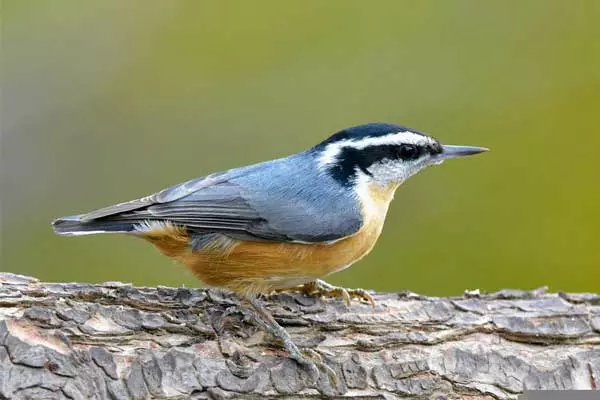
- Scientific Name: Sitta canadensis
- Length: 4.5 in
- Wingspan: 8.5 in
- Weight: 0.35 oz
Red-breasted nuthatches are the smallest nuthatch species found in Minnesota. These tiny birds measure as little as 4.5 inches long, span 8.5 inches across the wings, and weigh 0.35 ounces.
Identify red-breasted nuthatches by their blue-gray upperparts, cinnamon-orange underparts, white throats, and black stripes over the eyes. They also have straight gray beaks, long toes and claws, white supercilium (eyebrow), and black crowns.
Red-breasted nuthatches are permanent residents in northeastern and north-central Minnesota; some populations might move south each year to spend winter there.
The song of red-breasted nuthatches consists of a slowly repeated series of clear and rising notes that sound like “een-een-een“. These very small songbirds can be also recognized by their high-pitched, nasal, and weak “yank-yank” call.
Red-breasted Nuthatch Call | Source: National Park Service, Public domain, via Wikimedia Commons
Unlike their cousins, white-breasted nuthatches who prefer living in deciduous forests, red-breasted nuthatches can be mainly seen in coniferous woods of Minnesota.
They feed on insects and seeds, especially from conifers. Red-breasted nuthatches will hoard excess food by wedging nuts into the bark and then hammering them in with their beaks.
7. Boreal Chickadee

- Scientific Name: Poecile hudsonicus
- Length: 4.9–5.5 in
- Wingspan: 8.25 in
- Weight: 0.25–0.44 oz
Boreal chickadees are the smallest chickadee species found in Minnesota.
They measure 4.9-5.5 inches long and weigh as little as 0.25 ounces; their wingspan is around 8.25 inches. Identify boreal chickadees by their gray-brown upperparts, white underparts, brown flanks, brown caps, and gray wings and tails.
Boreal chickadees are permanent residents of northeastern parts of the state and can be seen there year-round. They inhabit boreal forests and breed from early May until August.
Pairs mate for life, nest in tree holes, and lay 5-7 white eggs with red spots.
Boreal chickadees’ most common call is a raspy “tschick-a-dee-dee” but they might also make some low garblings, short chirps, and squeals. They forage in small flocks on tree branches, feeding on insects and conifer seeds; they will also store different foods in trees for winter. This behavior is known as caching.
8. Brown Creeper

- Scientific Name: Certhia americana
- Length: 4.7–5.5 in
- Wingspan: 6.7–7.9 in
- Weight: 0.2–0.3 oz
Brown creepers are extremely small songbirds and the only members of the treecreeper family (Certhiidae) found in the USA. They are so small that they can weigh as little as 0.2 ounces!
Identify brown creepers by their dark brown upperparts with light spots, white underparts, thin slightly downcurved beaks, and broad stripes over the eye (supercilium). Such plumage camouflages these tiny birds well and makes them look like a piece of bark from distance.
Brown creepers are widespread throughout Minnesota; some populations in the northeast will stay year-round there, while others will move to southern parts of the state for winter.
Only the males sing and the song consists of high, thin notes that sound like “pee-pee-willow-wee“. Brown creepers’ call is a high-pitched “swee“.
Brown Creeper Call | Source: Jonathon Jongsma, CC BY-SA 3.0, via Wikimedia Commons
Brown creepers breed in coniferous forests, typically starting in April, and lay 3-7 eggs that both parents raise. They are omnivores that mainly feed on insects, spiders, and seeds.
Attract brown creepers to your backyard by adding seeds and suet to your feeder.
9. Common Yellowthroat

- Scientific Name: Geothlypis trichas
- Length: 4.3–5.1 in
- Wingspan: 5.9–7.5 in
- Weight: 0.3 oz
Common yellowthroats are small songbirds with rounded heads and medium-long, slightly rounded tails. They measure 5.9-7.5 inches across the wings and weigh on average 0.3 oz.
Identify common yellowthroats by their brown plumage, black facial masks, and yellow throats and undertails; females have no masks.
Common yellowthroats are breeding residents found statewide in Minnesota from late April to mid-October, around marshes, prairies, forests, and backyards. Towards the end of fall, they will migrate to winter in the southern US and South America.
The song of common yellowthroats is a loud “twichety-twichety-twichety-twich,” while their call is a soft “jip.”
Common Yellowthroat Song | Source: G. McGrane, Public domain, via Wikimedia Commons
They are also known as yellow bandits and will spend much of their time darting low in dense thickets and fields, catching small insects and spiders. Common yellowthroats love to nest around low areas of vegetation. They will build a cup-shaped nest and lay 3–5 eggs with both parents feeding the chicks.
10. Northern Parula
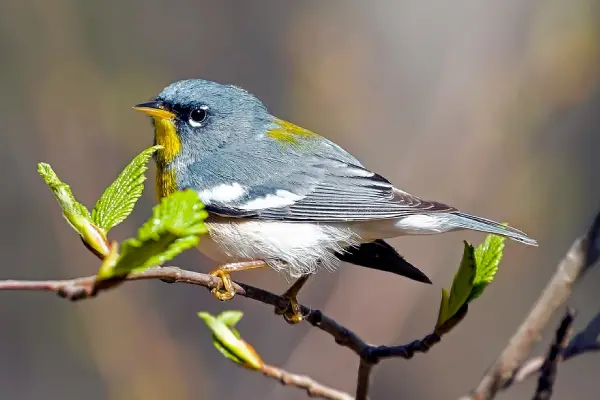
- Scientific Name: Setophaga americana
- Length: 4.3-4.9 in
- Wingspan: 6.3-7.1 in
- Weight: 0.18-0.39 oz
Northern parulas are acrobatic songbirds that are common during summer in forests and suburbs of northeastern Minnesota.
They are one of the smallest North American migratory warblers; shorter than common yellowthroats, and on average measure 0.1 inches less.
Northern parulas are very small birds with short tails and thin, pointy beaks. Identify them by their blue-gray upperparts, olive-green backs, yellow underparts, broken white eye arcs, and yellowish beaks and feet.
Northern parulas have two different songs: one is a rising buzzy trill that ends on a sharp note while the other has distinct pauses in between bouts of the trill. They also emit a sharp “chip” call.
Northen Parula Song | Source: G. McGrane, Public domain, via Wikimedia Commons
Northern parulas are monogamous warblers with rare cases of polygamy. They are omnivores that consume insects, spiders, and some berries.
11. LeConte’s Sparrow
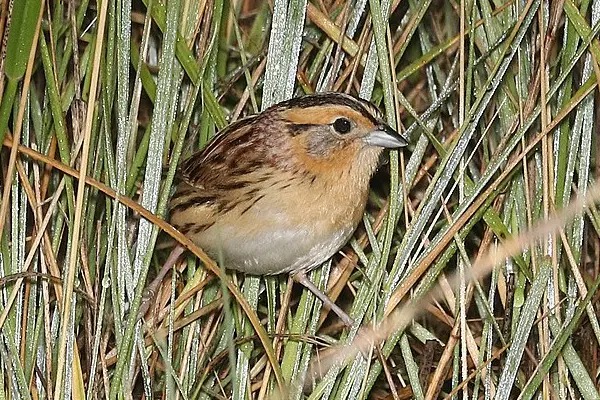
- Scientific Name: Ammospiza leconteii
- Length: 4.7 in
- Wingspan: 7.1 in
- Weight: 0.4-0.6 oz
LeConte’s sparrows are one of the smallest New World sparrows found in Minnesota. They measure just 4.7 inches in length, weigh as little as 0.4 oz, and span 7.1 inches across the wings!
They were discovered by an American ornithologist John James Audubon who named the species after his friend, doctor LeConte.
Identify LeConte’s sparrows by yellow-orange faces, silvery cheeks, spotted grayish napes, white bellies, and wings with black streaks.
LeConte’s sparrows are breeding residents of the northern half of Minnesota and can be seen there from spring to fall. They inhabit fields, prairies, marshy edges, and meadows with grasses and sedges.
Since they tend to stay rather hidden, the best way to identify them is by vocalizations. Male LeConte’s sparrows have a buzzy song that ends with a short chirp and is described as “tika-zzzzz-tik“. The call is a short “tsip“.
These tiny birds are omnivores and mainly feed on insects and spiders during summer and seeds during winter. They begin breeding around the end of April, have a clutch of 2-6 whitish eggs with brown dots, and the females are the ones to incubate the eggs.
Brown-headed cowbirds will often lay eggs in their nests for these sparrows to raise (a behavior known as brood parasitism).
12. Ruby-crowned Kinglet

- Scientific Name: Regulus calendula
- Length: 3.5-4.3 in
- Wingspan: 6.3-7.1 in
- Weight: 0.2-0.4 oz
Ruby-crowned kinglets are miniature greenish birds that measure 3.9 inches on average in length and weigh just 0.3 oz.
They are one of the smallest North American songbirds and can be identified by their olive-green colors, two white wing bars, and white eye-rings. Males also have red crown patches, which are usually concealed.
Ruby-crowned kinglets are breeding residents of northern Minnesota and can be seen in the state during summer. After that, they migrate south where they can be seen darting low in woods and thickets during winter.
Despite their compact size, they make very loud and complex sounds. Ruby-crowned kinglets’ song lasts around 5 seconds and has three parts: high-pitched “zee-zee” notes, low “turr” trills, and repeated “tee-da-leet” phrases. Their call is a harsh, fast, two-parted scold.
Ruby-crowned Kinglet Call | Source: G. McGrane, Public domain, via Wikimedia Commons
Ruby-crowned kinglets build cup-shaped nests and have the largest clutch of any North American passerine for their size. A female may lay up to 12 eggs and that entire clutch can weigh as much as the female herself. These birds are omnivores that mainly feed on insects, some fruits, and seeds.
13. Golden-crowned Kinglet
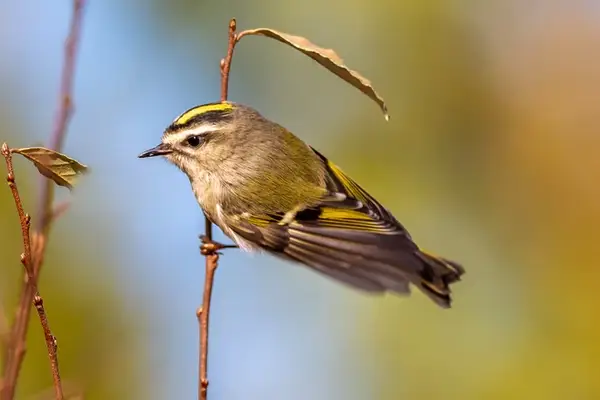
- Scientific Name: Regulus satrapa
- Length: 3.1-4.3 in
- Wingspan: 6.3-7.1 in
- Weight: 0.14-0.28 oz
Golden-crowned kinglets are tiny songbirds, one of the smallest in the United States.
They are greenish-gray above and grayish below; males have black eyelines, white eyebrows, and fiery orange crowns; females have yellow crowns.
Golden-crowned kinglets are common around the forests of Minnesota. They breed in coniferous forests and woodlands in northwestern parts and migrate to winter in coniferous, deciduous, and mixed forests and woodlands of southern parts.
They migrate from mid-March to mid-May and from early September to early December.
Golden-crowned kinglets’ song consists of a series of very high-pitched “tsee” notes.
Golden-crowned Kinglet Song | Source: G. McGrane, Public domain, via Wikimedia Commons
These minuscule birds are active foragers in trees and shrubs; their diet consists of insects, insect eggs, and spiders. Golden-crowned kinglets are also noted for their remarkable ability to survive cold weather and temperatures as low as -40°F.
14. Blue-gray Gnatcatcher
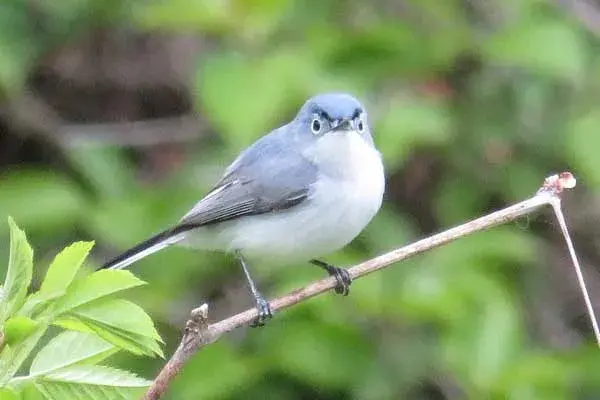
- Scientific Name: Polioptila caerulea
- Length: 3.9–5.1 in
- Wingspan: 6.3 in
- Weight: 0.18–0.25 oz
Blue-gray gnatcatchers are very small songbirds native to Minnesota.
When the breeding season comes, males will develop dark, V-shaped “eyebrow markings” that make them look like they are constantly annoyed.
Identify male blue-gray gnatcatchers also by the pale bluish heads and upperparts and white underparts. Females are less blue, while juveniles are greenish-gray. If you look closer, you will notice a white ring around the eyes.
Blue-gray gnatcatchers are breeding residents in southern and central Minnesota and can be commonly seen around open woods, oaks, pines, thickets, and urban areas of the state, from spring to fall.
They nest in trees and both partners participate in construction. Blue-gray gnatcatchers will use grass, weeds, plant fibers, and strips of bark as the basic material and spider web to bind it all together.
After breeding in open deciduous woods and shrublands, they migrate to winter in Southern USA, Mexico, Central America, Cuba, the Bahamas, and the Cayman Islands.
Listen for their “szpree-zpree-spreeeeey-spree-spre-sprzrreeeee” songs and high-pitched, nasal calls that sound like “zkreee-zkreee-zkreee.”
Blue-gray Gnatcatcher Song | Source: G. McGrane, Public domain, via Wikimedia Commons
Blue-gray gnatcatchers are monogamous and stay with their partners for life. Males can be particularly aggressive and will chase larger birds away from feeding areas or their nesting territory.
15. House Wren
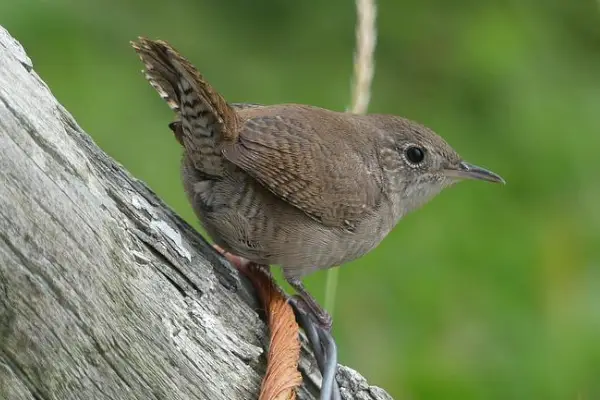
- Scientific Name: Troglodytes aedon
- Length: 4.3-5.1 in
- Wingspan: 5.9 in
- Weight: 0.35-0.42 oz
House wrens are one of the most common songbirds of Minnesota. They are brown above, grayish below, and have barrings on their wings and tails. Their heads are flat, beaks are curved, and short tails are usually held cocked.
House wrens are summer residents of Minnesota and can be seen in habitats ranging from forests to gardens. They breed in the state from April to July; best to see them there would be from March to mid-October.
House wrens are famous for their rush-and-jumble songs and will often make different harsh sounds: churrs, chatters, rattles, and scolds.
House Wren Call | Source: Jonathon Jongsma, CC BY-SA 3.0, via Wikimedia Commons
They might never visit your bird feeder but house wrens will fly through your backyard hunting insects. Most of their diet includes insects, spiders, and snails.
If you want to attract house wrens to your yard, try adding a bird house.
Among other places, house wrens are one of many birds commonly found in Northern California, Central Florida, and Northeast Ohio.
16. Sedge Wren
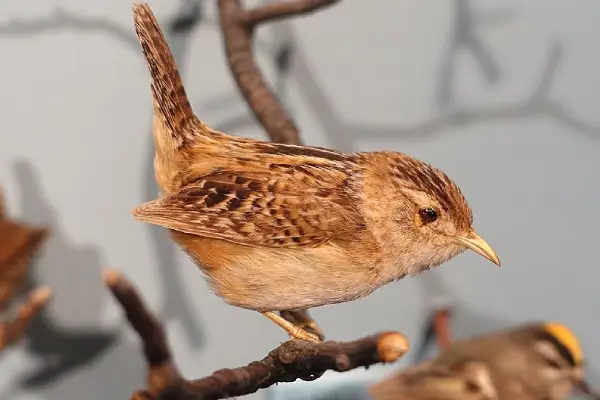
- Scientific Name: Cistothorus stellaris
- Length: 3.9-4.7 in
- Wingspan: 4.7-5.5 in
- Weight: 0.25-0.35 oz
Sedge wrens are one of the smallest birds found in Minnesota.
They can measure as little as 3.9 inches in length and weigh under 0.3 ounces! These miniature and secretive perching birds love to forage low in vegetation or on the ground, which might make them difficult to spot.
Identify sedge wrens by their streaky black, white, gray, and brown upperparts, pale buff underparts, and light brown eyebrows.
Sedge wrens are breeding residents of Minnesota and can be seen there from spring to fall, arriving around April and leaving in October. Similar to other wrens, males will build several nests; a female will choose one, line it with vegetation, and lay the eggs there.
They inhabit meadows and wet grasslands during their breeding season; they migrate to spend winters in southern parts of the USA, ranging from Texas to Virginia.
Male sedge wrens have a simple song that consists of several sharp notes and ends with a trill; the most common call is a sharp “tchap“. They are ground foragers and mainly feed on spiders and insects, including moths, flies, and grasshoppers.
Sedge Wren Call | Source: Jonathon Jongsma, CC BY-SA 3.0, via Wikimedia Commons
Read More: The smallest birds found in Texas
17. Ruby-throated Hummingbird
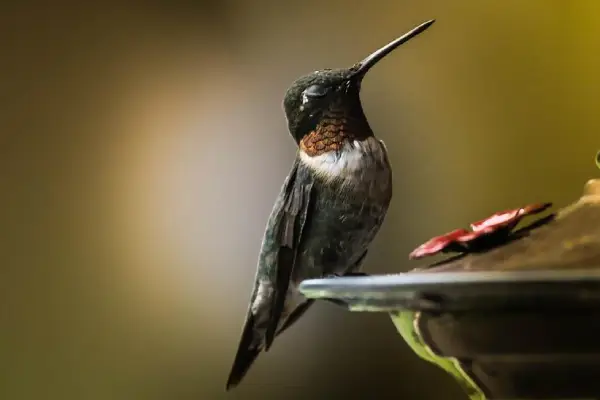
- Scientific Name: Archilochus colubris
- Length: 2.8-3.5 in
- Wingspan: 3.1-4.3 in
- Weight: 0.071-0.21 oz
Ruby-throated hummingbirds are the smallest birds in Minnesota. They can measure as little as 2.8 inches in length, span 3.1 inches across the wings, and weigh as little as 0.07 ounces which is less than a penny!
Don’t be fooled by their tiny size though – males will fiercely defend their territories against other males and larger birds up to the size of a hawk.
Identify male ruby-throated hummingbirds by their metallic emerald green upperparts, grayish-white underparts, black wings, and a gorget (throat patch) of iridescent ruby red. Their tails are forked.
Females are larger than males, have slightly shorter beaks, and have white throats. They also have long and narrow beaks that are perfect for sipping nectar from deep inside flowers; the beaks are black and take almost ¼ of their entire body length!
Ruby-throated hummingbirds are breeding residents of Minnesota. They will start arriving in Minnesota around the beginning of May and then begin migrating south as early as August – by October, most of them will be gone.
Ruby-throated hummingbirds have several calls: they make squeaky “chirps” to warn others when entering their territory and quick “tik-tik” sounds with wings when courting females.
Ruby-throated Hummingbird Call | Source: Unknown author, Public domain, via Wikimedia Commons
They also move very quickly, around 25 mph, and will beat their wing over 50 times per second. These birds are mostly solitary, except during the rather short breeding season.
Attract these minuscule birds to your backyard by setting up hummingbird feeders or planting tubular flowers. They are quite bold and might even feed at hanging plants and feeders on your porch or next to your windows!
Summary
This concludes our list of small birds in Minnesota.
Examples include different species of woodpeckers, kinglets, wrens, chickadees, and many others.
Feel free to use this list any time you need help recognizing these birds. And if you enjoyed our article, here are our other popular reads on birds: Examples of songbirds common in Minnesota